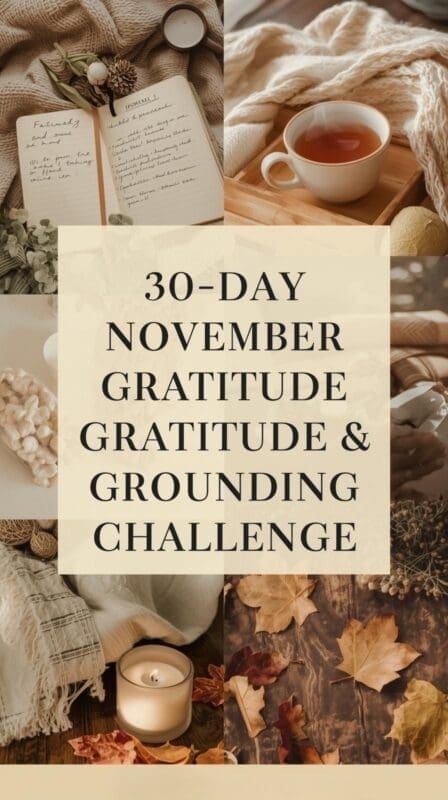November carries a quiet kind of beauty — the leaves fade, the light softens, and the air slows down before winter fully settles in.
It’s a month that naturally invites reflection.
But too often, we rush through it. We let the noise of deadlines, holidays, and routines numb us to what this time of year is meant to be: a pause.
That’s what this challenge is about — a gentle return to gratitude and grounded habits that help your nervous system feel safe again.
The Psychology Behind Grounded Habits
Our brains are wired for repetition. Every time you repeat an action, neurons strengthen their connection, forming a pathway that says, “This is what we do now.” That’s the foundation of habit stacking — connecting new habits to existing ones so they anchor naturally into your day.
Think of it like this:
You already make coffee every morning → add a 30-second gratitude reflection.
You already brush your teeth → follow it with a deep breath and gentle stretch.
You’re not adding chaos; you’re weaving calm into what’s already there.
This is why we’re starting in November — the perfect month for rewiring your daily rhythm before the rush of December. Small rituals of gratitude and grounding create stability that carries into the holidays (and beyond).
🧠 Mental health insight: Habit stacking uses “cue-based repetition” — the same mechanism that forms anxiety loops. But when redirected toward gratitude, it rewires your emotional baseline toward safety and contentment.
How to Use This Challenge
- Print or screenshot the daily list.
- Pick a consistent time — mornings or evenings work best.
- Pair each prompt with something you already do daily. (Habit stacking = less effort, more consistency.)
- Reflect weekly — don’t strive for perfection; aim for gentle progress.
By the end of these 30 days, you’ll have not only new habits — but new neural pathways for calm.
🌿 The 30-Day Gratitude & Grounding Challenge
Week 1 — Gratitude for the Ordinary
(Building awareness and sensory appreciation)
- Notice one thing in your morning routine you’re grateful for — and say it aloud.
- Eat one meal slowly, without distractions.
- Write down three things that went right today, however small.
- Light a candle intentionally — not for scent, but as a signal to slow down.
- Compliment someone sincerely.
- Go outside and notice 5 colors in nature.
- Reflect: What made me feel safe this week?
🧠 Focus: Strengthen awareness through sensory grounding.
Week 2 — Gratitude for Connection
(Nurturing relationships and compassion)
- Text or email someone you appreciate and tell them why.
- Write a note or letter to your younger self.
- Practice active listening — one full conversation without interrupting.
- Do one small act of service anonymously.
- Reflect: Who helps make my life easier in unseen ways?
- Make eye contact and smile at a stranger.
- Spend 10 minutes thinking of a person you’re thankful for and what they’ve taught you.
🧠 Focus: Cultivate oxytocin — the “bonding hormone” that lowers anxiety and builds empathy.
Week 3 — Gratitude for the Body
(Mind-body awareness and physical self-kindness)
- When you wake up, stretch and thank your body for something it does well.
- Take a mindful shower — feel the temperature, scent, and sound.
- Go for a slow walk, focusing only on your breath and steps.
- Eat something nourishing and notice its texture, color, and taste.
- Rest intentionally — lie down and let your body feel supported.
- Reflect: What signals does my body send when it needs care?
- Do something creative with your hands — drawing, baking, or gardening — and stay present.
🧠 Focus: Grounding through embodiment; interoception strengthens emotional regulation.
Week 4 — Gratitude for Growth
(Reflection, release, and intention-setting)
- Write down three challenges you faced this year — and what they taught you.
- Declutter one small space that drains your energy.
- Take a digital detox for one evening.
- Write a “thank you” letter to a difficult experience.
- Journal: What kind of person am I becoming?
- Light a candle or incense and breathe — envision releasing what’s no longer needed.
- End your day listing three moments of peace you felt this week.
🧠 Focus: Integrate gratitude with growth — the foundation of resilience.
Final Two Days — Gratitude for Stillness
(Integrating calm before the holidays)
- Sit in silence for 5 minutes. No music, no phone. Just notice.
- Write one sentence to yourself: “In this season, I’m grateful for…”
Keep this note visible — on your mirror, desk, or journal. Let it remind you that gratitude doesn’t end with this month. It’s a practice that carries you softly into winter.
🌙 Gentle Implementation Tips
- Stack habits: Pair gratitude moments with routines you already do.
- Track progress: Use a calming printable checklist or bullet journal.
- Don’t rush: Missed a day? Repeat it — growth isn’t linear.
- Anchor with sensory cues: Scent (lavender), sound (soft playlist), or texture (warm blanket) help the brain associate safety with your new rituals.
🧠 Science-backed note: Studies show that after 21–30 days of consistent gratitude journaling, neural activity in the medial prefrontal cortex (linked to empathy and emotion regulation) becomes stronger — meaning gratitude literally changes how you experience the world.
🌾 Final Reflection
As the year winds down, this challenge isn’t about becoming a new person — it’s about remembering yourself.
The calm, grateful, grounded version of you is already here — this month, you’re just practicing how to listen to her again.
“Peace isn’t found when life slows down. It’s found when you do.”

About the Author
Hi, I’m Eve, a former school counselor with a master’s degree in School Psychology and a passionate advocate for children and families navigating sensory challenges. As a mom of children with sensory sensitivities, I deeply understand the journey special-needs parents face, and I dedicate myself to researching and sharing practical solutions to help children thrive and feel comfortable in their bodies. My goal is also to empower counselors, therapists, and psychologists with creative strategies and supportive resources to enrich their everyday practice. When I’m not writing or exploring new therapeutic approaches, you’ll find me spending quality time with my family and continually seeking inspiration from everyday moments.



